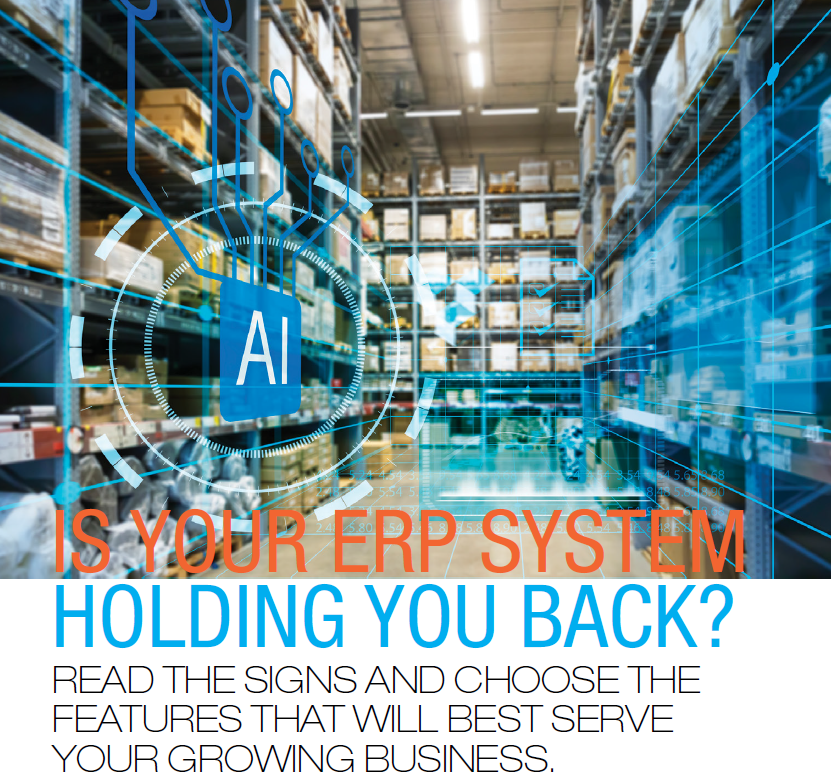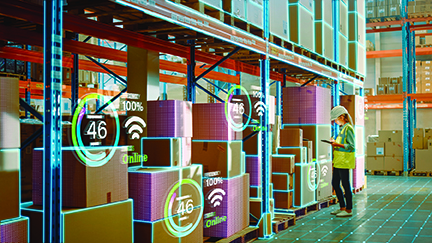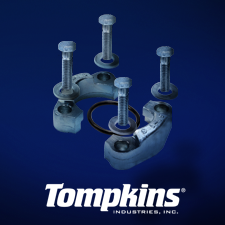 |
| istockphoto.com |
by Kim Phelan
Savvy distribution leaders know there’s a right time for everything in the business, be it an M&A market expansion, a facility renovation, or a capital equipment investment. The key is recognizing the signs and knowing when to seize the moment. So, what about your company’s enterprise resource planning system – aka, ERP? When is the right time to start thinking about replacing it? What will be the signs you and your IT people observe? Will they be obvious or subtle?
 |
| Kaminstein |
“Legacy ERP systems often become a liability rather than an asset,” said Dan Kaminstein, senior principal product manager at Epicor. “Aging servers, disconnected systems, and poor remote access not only slow down operations but also expose the business to rising IT costs and security vulnerabilities.”
Kaminstein adds, “When distributors struggle to generate reliable reports or access real-time data, it’s a clear signal their ERP is no longer meeting business needs.”
Operational inefficiencies, such as manual processes, lack of automation, and disruptions in workflows, are also red flags that indicate it’s time to replace your ERP, according to Kaminstein. These inefficiencies can significantly hinder growth, especially when distributors are unable to adapt quickly to changing customer demands.
“Further, legacy ERP systems often carry hidden costs that accumulate,” he said. “Renewal rates, third-party add-ons, and costly customizations can make older systems more costly than modern alternatives.”
Kelly Squizzero, senior product manager at Acumatica adds that distributors should consider replacing their ERP when the system limits their ability to grow, adapt, or serve customers effectively.
 |
| Squizzero |
RED FLAGS
“Common warning signs include heavy reliance on spreadsheets and manual workarounds, which indicate the ERP solution is creating inefficiencies rather than alleviating them. Another red flag is a lack of real-time visibility into inventory, order status, and financials, as delayed insights or siloed information can hinder smart decision-making,” she continued. “Legacy systems that are inflexible or unable to integrate with modern tools, e-commerce platforms, or supplier systems also create disconnects across the value chain.
“As distributors expand into new markets or business lines, outdated systems often can’t scale to keep up, and on-premises solutions typically require expensive maintenance and upgrades. When these issues surface, it’s clear the existing system is holding the business back instead of supporting its future growth.”
 |
| Baumbach |
Growth, or the ability to scale, is the No. 1 signal that it’s time to search for a new system, according to Werner Baumbach, global vice president wholesale distribution at SAP. But other signs will be evident – here’s the writing on the wall he says distributors should watch for:
1) Mounting costs: Expensive, often unstable custom software integrations are required for on-premise systems to talk to one another. If you’re not running on a cloud ERP, that alone says it’s time to update. But make sure any cloud ERP that you choose doesn’t just scale for growth. It should offer the ability to integrate with suppliers and offer end-to-end functionality from accounting to customers to maximizing cost reductions, that future-proofs your system. Embedded generative and agentic AI will continue to evolve and reduce costs long term.
2) Information silos: Just because you’re using ERP today doesn’t mean that your analytics application is working for you – and it should be. If your data is scattered, obscured or difficult for people to access, the lack of timely, trusted, and accessible information stifles strategic dialogue. It also affects planning and collaboration within and across teams and physical locations. And it makes sustaining a cohesive, collaborative culture difficult, and puts you at a disadvantage with suppliers and customers. The days of data warehouses are long gone – virtual data lakes and AI are making what-if scenario modeling and rapid response possible in ways standard analytics can’t.
3) Cumbersome business processes: If we’re talking about updating ERP, we have to talk about the power of agentic AI. Beyond automation, agentic AI improves productivity. It further reduces the time people spend doing research, preparing transactions, and communicating with suppliers and customers, helping the business be as nimble as it needs to be to compete. Basic automation, for example, can still leave too many invoices needing exception-handling, causing delays that hamper cash flow. Beyond generative AI, agentic AI lets different areas of the software talk to each other. That means they can resolve more exceptions and take even more routine work off the plate of your operations team than automation.
 |
| istockphoto.com |
4) Sub-par customer experiences: ERP is about the promise of integrated business, but if your ERP isn’t offering the best possible, modern customer experience, it’s time to consider an upgrade. If customers are struggling through systems or touchpoints with your company to get the information they need, your brand image will suffer and so will your bottom line. The same is true if employees have difficulty providing customers with real-time information about orders and requests.
5) Missed opportunities: If your sales team is missing cross-sell and upsell opportunities because they lack the full picture of customers, it’s time to bring in an ERP that does. And if your system doesn’t offer the flexibility to understand a customer’s purchase history, preferences, eligibility for rebates and the like, it’s time to look for an ERP that closes the gap. Well-quipped sales teams also help improve customer retention and satisfaction.
“If issues like these have surfaced in your company, it’s time to consider upgrading your ERP to one designed to support growth-minded businesses,” Baumbach said.
 |
| Horrigan |
William Horrigan, vice president sales and marketing at Tribute Inc., sums up the collective wisdom of ERP experts: “You’ll know it’s time to replace your ERP system when it starts holding you back instead of driving you forward. If everyday tasks require multiple manual steps, or if your team struggles to access information across multiple locations, that’s a clear signal. For distributors, visibility across branches is mission-critical while being able to see available inventory in real time, easily transfer stock, and remotely source products is what keeps customers satisfied and loyal.
“Another red flag is outdated technology,” Horrigan adds. “If your current ERP is aging and no longer keeping pace with modern tools, you’re missing out on productivity gains that niche ERP systems can deliver.
“In niche markets especially, distributors need functionality tailored to their industry. For example, our company specializes in five vertical markets: fluid power, industrial and hydraulic hose, service and repair, and rubber products like conveyor belting, gaskets, seals, and O-rings,” he continued. “Each of these requires very specific features to effectively serve the customer. If your ERP can’t support those unique needs, it’s time to consider a change.”
WHAT TO CONSIDER IN YOUR SEARCH
“First and foremost, choose a vendor who truly knows your business,” said Horrigan. “Working with a niche provider means they already understand your industry’s requirements. Otherwise, you’ll spend valuable time and money educating a generalist software company on how you operate, instead of focusing on streamlining processes and driving growth.”
He recommends looking for:
- Built-in best practice tools that help eliminate old bad habits rather than simply digitizing them. A good ERP should improve your workflows and provide a real return on your strategic investment.
- The ability to deliver end-to-end visibility, whether it’s across locations, in your supply chain, or in customerfacing interactions. The ability to instantly see inventory, track orders, and manage service commitments is no longer optional – it’s expected.
- Scalability and flexibility. As your business grows, your ERP should grow with you, adapting to changing market needs without forcing costly workarounds.
 |
| istockphoto.com |
Additionally, sources identified the following features that will serve growing distributors well in the long term:
From Baumbach at SAP –
Warehouse management system. No way around it – that will always be top of mind and No. 1. Especially look for the ability to support: value-added services (e.g., kitting/assembly, light manufacturing, relabeling, customer-specific packing and charge capture; 3PL billing if relevant) and directed, rules-driven tasks (slotting, replenishment triggers, travel path optimization, dynamic wave planning (order, waveless, batch/cluster, zone), cross-dock, cartonization, and pack station support); and mobile-first execution.
Integration. Your ERP needs to have robust integration capabilities, within your operations and beyond, because extensibility is key to future-proofing your system and business. Today this means having end-to-end execution and visibility, including order promising (ATP), sourcing, pick/pack/ship, and delivery status across system and company boundaries. Integration also supports agility and growth, integrating with 3PLs, dropship programs, carriers, automation (AMRs, put walls) and more. An ERP with prebuilt connectors and a robust extensibility model lets you launch key capabilities in weeks, not quarters. And real-time integrations turn your ERP into a command center instead of a record-keeping silo – this also means ideally an embedded data analytics suite, but at a minimum, the ability to integrate with one.
Agentic AI. Generative AI is table stakes today, while agentic AI is the future of ERP. Systems that will not only grow with your business but continuously modernize it will provide functionality like giving you a choice of models (vendor-provided and BYO like Azure OpenAI/Anthropic/ Google), versioning, caching, and cost/latency controls. It should support no/low-code composition capabilities, including templates for common distribution skills and a canvas to chain tools, prompts, and approvals without heavy custom code. And you want to look for something secure, and integration-aware. Something with agents that can call internal ERP APIs and external connectors (EDI, marketplaces, carriers, 3PLs) safely, and provide security/compliance with standards like SOC 2/ISO 27001, plus data residency options, tenant isolation, encryption at rest/in transit, zero data retention with third-party LLMs.
From Squizzero at Acumatica –
Cloud-based architecture. This provides secure access anywhere, anytime, ensuring remote teams have the same visibility as those at headquarters. Embedded analytics and reporting – such as built-in dashboards and AI-driven insights – empower leaders to make faster, data-informed decisions. Just as important is industryspecific functionality that supports every aspect of the business, from inventory and pricing to customer engagement, helping distributors avoid costly customization and stay aligned with their operational needs.
Robust supply chain capabilities tailored to distribution. Real-time inventory and warehouse management features – such as automated tracking, demand forecasting, and integrated purchasing – enable businesses to optimize stock levels, reduce carrying costs, and respond quickly to shifting demand. Industry-specific tools like lot and serial number tracking further enhance visibility and control across complex supply networks.
Seamless support for e-commerce and customer portal integration. Connecting with e-commerce platforms creates a unified customer journey – from browsing to fulfillment – while improving visibility into orders, inventory, and service interactions. Distribution-focused features such as flexible pricing and real-time availability ensure that customer-facing experiences are accurate, efficient, and aligned with backend operations.
From Kaminstein at Epicor –
AI-infused intelligence. Modern ERP systems are increasingly powered by embedded artificial intelligence, enabling predictive analytics, automated decision-making, and machine learning to optimize operations. These capabilities enable distributors to anticipate demand, streamline workflows, and make smarter, faster decisions across the business.
Inventory and pricing optimization. Advanced ERP platforms now offer dual optimization capabilities: intelligent inventory management and strategic pricing. For inventory, dynamic replenishment methods reduce carrying costs and improve turns. For pricing, algorithms segment customers and recommend margin-maximizing strategies based on order history, product type, and price sensitivity.
Business intelligence and reporting. Real-time visibility is no longer a luxury; it’s a necessity. Today’s ERP systems deliver dynamic dashboards, automated reporting, and native integrations that empower distributors to monitor performance, uncover trends, and act on insights with confidence and speed.
Cloud deployment and security. Cloud-based ERP solutions offer secure, scalable environments with automatic updates and flexible deployment options. These solutions are often backed by enterprise-grade platforms, such as Microsoft Azure which provide robust encryption and dedicated databases.
Scalability. A modular, composable ERP architecture ensures that distributors can scale as they grow. By leveraging AI and flexible integrations, these systems adapt to evolving business needs such as expanding into new markets, launching new services, or responding to shifts in customer demand.
 |
| istockphoto.com |
NEW DEVELOPMENTS IN ERPS
Innovations from Epicor:
- Prism for Prophet 21 leverages a network of agentic AI agents to help users interact with Prophet 21 using natural language. It leverages large language models (LLM) and retrieval-augmented generation (RAG) to deliver real-time responses, automate tasks, navigate complex reports, and surface data to assist in decision-making.
- Grow Data Platform is a full-stack, AI-powered, no-code data platform designed to help distributors bring together data from across their entire ecosystem. Full-stack includes all the essential components – data storage, transformation, integration, AI-powered analytics, and visualization – all of which are integrated into the Grow Data Platform.
- Grow AI Item Advisor is an embedded intelligence tool that uses machine learning to recommend related items in real-time during the order entry process, capitalizing on cross-selling opportunities employees may have otherwise missed and potentially driving revenue.
- Ascend with Epicor is a comprehensive cloud migration program designed to help customers migrate to the cloud with speed and confidence. Built on proven Epicor Signature Methodology, Ascend offers a migration solution that includes detailed project scoping, secure data packaging and transfer, and tailored support for customizations.
Acumatica evolves to meet changing demands:
The company recently introduced intelligent tools like the AI-powered Cross-Sell Assistant, which analyzes customer buying patterns to suggest complementary products and increase average order value.
Acumatica also launched powerful new order orchestration capabilities that automate fulfillment decisions based on inventory availability, warehouse pairings, and sourcing rules – helping distributors streamline operations and reduce delays.
In addition, they expanded their commerce integrations, strengthening connections to platforms like Shopify and Amazon to support a seamless omnichannel experience and unified order management. The company also added more personalization options within the user interface to improve usability, giving employees greater control over dashboards, workflows, and collaboration tools.
Enhanced integration from SAP:
To support the challenging operating environment distributors are faced with, SAP recently delivered enhanced integration between supply chain management and SAP Global Trade Services (SAP GTS). Specifically, integration with SAP GTS supports the execution of the outbound, or export, process. This enables customers to conduct compliance checks for freight units and freight orders and complete export declaration for consignments and freight orders including Sanctioned Party List (SPL) screenings, embargo checks, and legal control checks (export). Additionally, export declaration for consignment orders and freight orders is provided including status handling, customs invoice creation, and export of declaration requests.
Tribute delivers measurable results:
Tribute notes that the integration of AI functionality directly into its ERP is the biggest game-changer – enabling distributors to better serve their customers.
The company has also established a Program Review Committee, which prioritizes enhancements and feature requests that come in throughout the year. Their goal is simple: Identify the changes that will have the biggest impact on productivity and profitability. This ensures that Tribute’s ERP evolves in step with the market and continues to deliver measurable results for distributors.
This article originally appeared in the November/December 2025 issue of Industrial Supply magazine. Copyright 2025, Direct Business Media.













